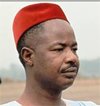 He was born in Garoua and entered the politics during the 1940s, by then French Cameroon. He was elected president of French Cameroon just when it gained independence in 1960 as leader of the Cameroon Union, prominent political party at the time. At this time, the southern section of Cameroon was under British rule but he persuaded this part of British Cameroon to join French Cameroon. A general disease with most African leaders, he was reelected in 1965, 1970, 1975 and 1980, establishing the complete dominance of his party and banning all others in 1976.
He was born in Garoua and entered the politics during the 1940s, by then French Cameroon. He was elected president of French Cameroon just when it gained independence in 1960 as leader of the Cameroon Union, prominent political party at the time. At this time, the southern section of Cameroon was under British rule but he persuaded this part of British Cameroon to join French Cameroon. A general disease with most African leaders, he was reelected in 1965, 1970, 1975 and 1980, establishing the complete dominance of his party and banning all others in 1976.
In spite of threats to his authority like the rebellion in the 1960s from the political party known as Union des Peuples Camerounais (UPC), he quelled them all and stabilized power. He practiced dictatorship but had ensured one of the most stable rules in Africa at the time.
Tricked by a French doctor he resigned on 4 November 1982 for health reasons, and was succeeded by Paul Biya, Prime Minister two days later. That he stepped down in favor of Biya, a Christian from the south and not a Muslim from the north like himself, was considered surprising. Ahidjo's ultimate intentions are unclear; it is possible that he intended to return to the presidency at a later point when his health improved, and another possibility is that he intended this post for Maigari Bello Bouba, a fellow Muslim from the north who succeeded Biya as Prime Minister, to be his eventual successor as President, with Biya in effectively a caretaker role. Although the Central Committee of the ruling Cameroon National Union (CNU) urged Ahidjo to remain president, he declined to do so, but he did agree to remain as the leader of the CNU. However, he also arranged for Biya to become the CNU vice-president and handle party affairs in his absence. Additionally, in January 1983, Ahidjo travelled across the country in a tour in support of Biya.
Later in 1983, a major feud developed between Ahidjo and Biya. On July 19, 1983, Ahidjo went into exile in France, and Biya began removing Ahidjo's supporters from positions of power and eliminating symbols of his authority, replacing Ahidjo's portraits with his own and removing Ahidjo's name from the anthem of the CNU. On August 22, Biya announced that a plot allegedly involving Ahidjo had been uncovered. For his part, Ahidjo severely criticized Biya, alleging that Biya was abusing his power, that he lived in fear of plots against him, and that he was a threat to national unity. The two were unable to reconcile despite the efforts of several foreign leaders, and Ahidjo announced on August 27 that he was resigning as head of the CNU. In exile, Ahidjo was sentenced to death in absentia in February 1984, along with two others, for participation in the June 1983 coup plot, although Biya commuted the sentence to life in prison. Ahidjo denied involvement in the plot. A violent but unsuccessful coup attempt in April 1984 was also widely believed to have been orchestrated by Ahidjo.
In his remaining years, Ahidjo divided his time between France and Senegal. He died in Dakar and till date his corps has never returned in spite of constant rumors of plans to do so.
Read about current Presidents Paul Biya

